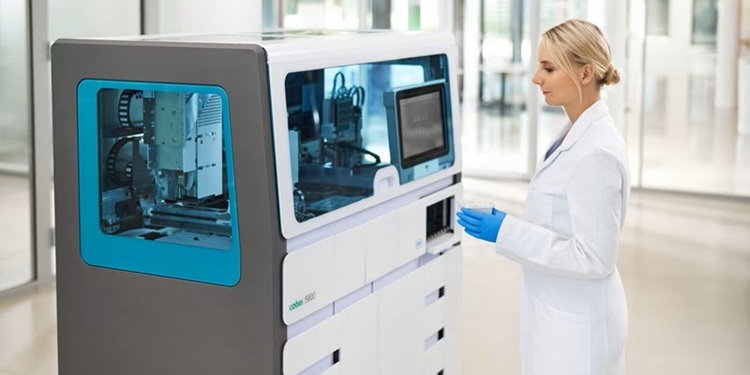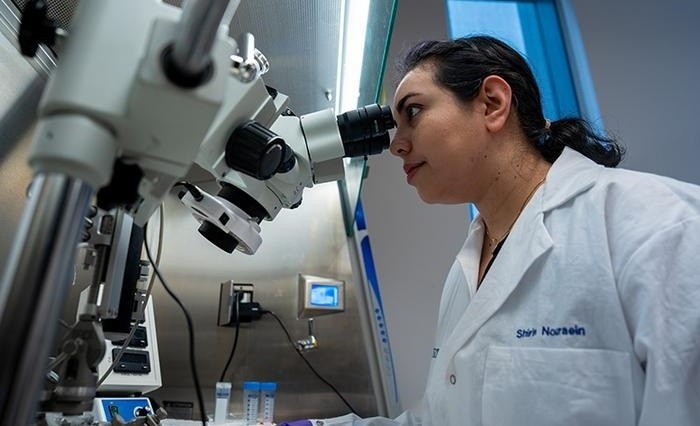FTIR-Based Saliva Test Detects Body’s Response to COVID-19
|
By LabMedica International staff writers Posted on 11 Mar 2022 |

A potential new saliva test can rapidly detect COVID-19 infection and may even indicate if a person is likely to become seriously unwell by reading the chemical signature in a person’s saliva. The researchers found the test worked by detecting the body’s response to COVID-19 rather than just the virus itself – making it different from PCR and rapid antigen tests. In addition, the researchers also established a decontamination procedure that would allow infected samples to be safely handled and tested on the spot.
In a study, researchers at the QIMR Berghofer Medical Research Institute (Brisbane, Australia) collaborated with Agilent Technologies Inc. (Santa Clara, CA, USA) on a proof-of-concept FTIR-based saliva COVID-19 testing workflow using the Agilent Cary 630 FTIR Spectrometer. The study investigated the pathophysiological response to a COVID-19 infection through ATR-FTIR spectroscopy. The researchers acquired infrared spectra of saliva samples following a quick and simple sample preparation requiring only ethanol and basic laboratory equipment. An infrared spectrum can be considered as a biochemical snapshot of the saliva sample including a COVID-19 immune response signature. Unlike other testing technologies such as PCR testing or rapid antigen test, the ATR-FTIR method analyses the pathophysiological responses of the human body rather than detecting the pathogen/antigen itself, which is thought to make this method more robust against virus mutations.
“We applied a simple ethanol decontamination procedure for biosafe handling of self-collected saliva samples. A basic step of significant importance for any test that has the potential to be used in non-clinical environments such as in remote areas or in scenarios where large crowds require rapid testing, for example, in airports, or sports stadiums,” explained associate professor Michelle Hill, head of QIMR Berghofer’s Precision and Systems Biomedicine Research Group, and one of the lead scientists of the study.
“Earlier research studies on ATR-FTIR for COVID-19 saliva testing were not conclusive on the biological basis for the saliva testing methodology. To shine a light on this aspect, we also conducted controlled infection experiments on cells and mice models and established the most characteristic COVID-19 positive spectral signature. We integrated our data from in vitro cell studies, in vivo mouse studies, and independent human cohort studies, as well as data from recent publications to demonstrate the robustness of the methodology,” Hill added.
“We are very excited about this research study. FTIR spectroscopy is an easy-to-use analytical technique, uses minimal consumables, and provides results in seconds,” said Andrew Hind, associate vice president of Research and Development for the Molecular Spectroscopy Division at Agilent. “It emphasizes the potential of ATR-FTIR spectroscopy for life science and infectious disease research. Agilent funded parts of this research work through the Agilent Technologies Applications and Core Technology - University Research Grant and provided the Cary 630 FTIR Spectrometer. We will continue to support work in the field of COVID-19 and infectious diseases research.”
Related Links:
QIMR Berghofer Medical Research Institute
Agilent Technologies Inc.
Latest COVID-19 News
- New Immunosensor Paves Way to Rapid POC Testing for COVID-19 and Emerging Infectious Diseases
- Long COVID Etiologies Found in Acute Infection Blood Samples
- Novel Device Detects COVID-19 Antibodies in Five Minutes
- CRISPR-Powered COVID-19 Test Detects SARS-CoV-2 in 30 Minutes Using Gene Scissors
- Gut Microbiome Dysbiosis Linked to COVID-19
- Novel SARS CoV-2 Rapid Antigen Test Validated for Diagnostic Accuracy
- New COVID + Flu + R.S.V. Test to Help Prepare for `Tripledemic`
- AI Takes Guesswork Out Of Lateral Flow Testing
- Fastest Ever SARS-CoV-2 Antigen Test Designed for Non-Invasive COVID-19 Testing in Any Setting
- Rapid Antigen Tests Detect Omicron, Delta SARS-CoV-2 Variants
- Health Care Professionals Showed Increased Interest in POC Technologies During Pandemic, Finds Study
- Set Up Reserve Lab Capacity Now for Faster Response to Next Pandemic, Say Researchers
- Blood Test Performed During Initial Infection Predicts Long COVID Risk
- Low-Cost COVID-19 Testing Platform Combines Sensitivity of PCR and Speed of Antigen Tests
- Finger-Prick Blood Test Identifies Immunity to COVID-19
- Quick Test Kit Determines Immunity Against COVID-19 and Its Variants
Channels
Clinical Chemistry
view channel
Chemical Imaging Probe Could Track and Treat Prostate Cancer
Prostate cancer remains a leading cause of illness and death among men, with many patients eventually developing resistance to standard hormone-blocking therapies. These drugs often lose effectiveness... Read more
Mismatch Between Two Common Kidney Function Tests Indicates Serious Health Problems
Creatinine has long been the standard for measuring kidney filtration, while cystatin C — a protein produced by all human cells — has been recommended as a complementary marker because it is influenced... Read moreMolecular Diagnostics
view channel
Genetic Marker to Help Children with T-Cell Leukemia Avoid Unnecessary Chemotherapy
About 400 children in the UK are diagnosed with acute lymphoblastic leukemia (ALL) each year, with roughly 15% presenting with a more aggressive T-ALL subtype. While the standard approach is a four-week... Read more
Four-Gene Blood Test Rules Out Bacterial Lung Infection
Lower respiratory tract infections (LRTIs) are among the most common reasons for antibiotic prescriptions, yet distinguishing bacterial infections from viral ones remains notoriously difficult.... Read more
New PCR Test Improves Diagnostic Accuracy of Bacterial Vaginosis and Candida Vaginitis
Bacterial vaginosis (BV) impacts approximately 25% of women of reproductive age, while up to 75% of women experience candida vaginitis (CV) at least once in their lifetime. Vaginal symptoms are one of... Read moreHematology
view channel
Platelet Activity Blood Test in Middle Age Could Identify Early Alzheimer’s Risk
Early detection of Alzheimer’s disease remains one of the biggest unmet needs in neurology, particularly because the biological changes underlying the disorder begin decades before memory symptoms appear.... Read more
Microvesicles Measurement Could Detect Vascular Injury in Sickle Cell Disease Patients
Assessing disease severity in sickle cell disease (SCD) remains challenging, especially when trying to predict hemolysis, vascular injury, and risk of complications such as vaso-occlusive crises.... Read more
ADLM’s New Coagulation Testing Guidance to Improve Care for Patients on Blood Thinners
Direct oral anticoagulants (DOACs) are one of the most common types of blood thinners. Patients take them to prevent a host of complications that could arise from blood clotting, including stroke, deep... Read moreImmunology
view channel
New Test Distinguishes Vaccine-Induced False Positives from Active HIV Infection
Since HIV was identified in 1983, more than 91 million people have contracted the virus, and over 44 million have died from related causes. Today, nearly 40 million individuals worldwide live with HIV-1,... Read more
Gene Signature Test Predicts Response to Key Breast Cancer Treatment
DK4/6 inhibitors paired with hormone therapy have become a cornerstone treatment for advanced HR+/HER2– breast cancer, slowing tumor growth by blocking key proteins that drive cell division.... Read more
Chip Captures Cancer Cells from Blood to Help Select Right Breast Cancer Treatment
Ductal carcinoma in situ (DCIS) accounts for about a quarter of all breast cancer cases and generally carries a good prognosis. This non-invasive form of the disease may or may not become life-threatening.... Read moreMicrobiology
view channel
Rapid Diagnostic Test Matches Gold Standard for Sepsis Detection
Sepsis kills 11 million people worldwide every year and generates massive healthcare costs. In the USA and Europe alone, sepsis accounts for USD 100 billion in annual hospitalization expenses.... Read moreRapid POC Tuberculosis Test Provides Results Within 15 Minutes
Tuberculosis remains one of the world’s deadliest infectious diseases, and reducing new cases depends on identifying individuals with latent infection before it progresses. Current diagnostic tools often... Read more
Rapid Assay Identifies Bloodstream Infection Pathogens Directly from Patient Samples
Bloodstream infections in sepsis progress quickly and demand rapid, precise diagnosis. Current blood-culture methods often take one to five days to identify the pathogen, leaving clinicians to treat blindly... Read morePathology
view channelAI Tool Outperforms Doctors in Spotting Blood Cell Abnormalities
Diagnosing blood disorders depends on recognizing subtle abnormalities in cell size, shape, and structure, yet this process is slow, subjective, and requires years of expert training. Even specialists... Read more
AI Tool Rapidly Analyzes Complex Cancer Images for Personalized Treatment
Complex digital biopsy images that typically take an expert pathologist up to 20 minutes to assess can now be analyzed in about one minute using a new artificial intelligence (AI) tool. The technology... Read moreTechnology
view channel
Artificial Intelligence Model Could Accelerate Rare Disease Diagnosis
Identifying which genetic variants actually cause disease remains one of the biggest challenges in genomic medicine. Each person carries tens of thousands of DNA changes, yet only a few meaningfully alter... Read more
AI Saliva Sensor Enables Early Detection of Head and Neck Cancer
Early detection of head and neck cancer remains difficult because the disease produces few or no symptoms in its earliest stages, and lesions often lie deep within the head or neck, where biopsy or endoscopy... Read moreIndustry
view channel
Abbott Acquires Cancer-Screening Company Exact Sciences
Abbott (Abbott Park, IL, USA) has entered into a definitive agreement to acquire Exact Sciences (Madison, WI, USA), enabling it to enter and lead in fast-growing cancer diagnostics segments.... Read more
























